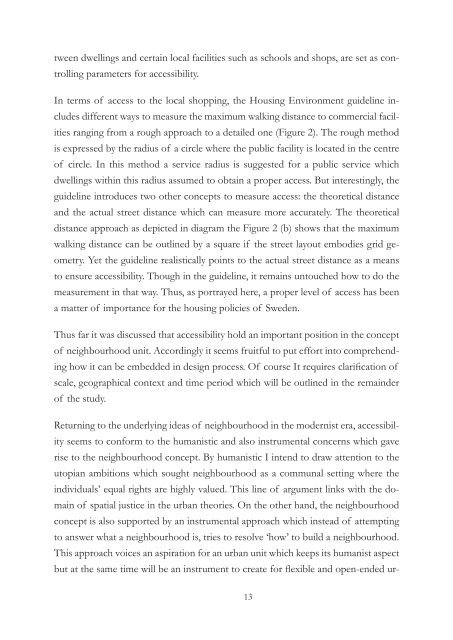Accessibility and Street Layout Exploring spatial equity in
Accessibility and Street Layout Exploring spatial equity in
Accessibility and Street Layout Exploring spatial equity in
You also want an ePaper? Increase the reach of your titles
YUMPU automatically turns print PDFs into web optimized ePapers that Google loves.
tween dwell<strong>in</strong>gs <strong>and</strong> certa<strong>in</strong> local facilities such as schools <strong>and</strong> shops, are set as controll<strong>in</strong>g<br />
parameters for accessibility.<br />
In terms of access to the local shopp<strong>in</strong>g, the Hous<strong>in</strong>g Environment guidel<strong>in</strong>e <strong>in</strong>cludes<br />
different ways to measure the maximum walk<strong>in</strong>g distance to commercial facilities<br />
rang<strong>in</strong>g from a rough approach to a detailed one (Figure 2). The rough method<br />
is expressed by the radius of a circle where the public facility is located <strong>in</strong> the centre<br />
of circle. In this method a service radius is suggested for a public service which<br />
dwell<strong>in</strong>gs with<strong>in</strong> this radius assumed to obta<strong>in</strong> a proper access. But <strong>in</strong>terest<strong>in</strong>gly, the<br />
guidel<strong>in</strong>e <strong>in</strong>troduces two other concepts to measure access: the theoretical distance<br />
<strong>and</strong> the actual street distance which can measure more accurately. The theoretical<br />
distance approach as depicted <strong>in</strong> diagram the Figure 2 (b) shows that the maximum<br />
walk<strong>in</strong>g distance can be outl<strong>in</strong>ed by a square if the street layout embodies grid geometry.<br />
Yet the guidel<strong>in</strong>e realistically po<strong>in</strong>ts to the actual street distance as a means<br />
to ensure accessibility. Though <strong>in</strong> the guidel<strong>in</strong>e, it rema<strong>in</strong>s untouched how to do the<br />
measurement <strong>in</strong> that way. Thus, as portrayed here, a proper level of access has been<br />
a matter of importance for the hous<strong>in</strong>g policies of Sweden.<br />
Thus far it was discussed that accessibility hold an important position <strong>in</strong> the concept<br />
of neighbourhood unit. Accord<strong>in</strong>gly it seems fruitful to put effort <strong>in</strong>to comprehend<strong>in</strong>g<br />
how it can be embedded <strong>in</strong> design process. Of course It requires clarification of<br />
scale, geographical context <strong>and</strong> time period which will be outl<strong>in</strong>ed <strong>in</strong> the rema<strong>in</strong>der<br />
of the study.<br />
Return<strong>in</strong>g to the underly<strong>in</strong>g ideas of neighbourhood <strong>in</strong> the modernist era, accessibility<br />
seems to conform to the humanistic <strong>and</strong> also <strong>in</strong>strumental concerns which gave<br />
rise to the neighbourhood concept. By humanistic I <strong>in</strong>tend to draw attention to the<br />
utopian ambitions which sought neighbourhood as a communal sett<strong>in</strong>g where the<br />
<strong>in</strong>dividuals’ equal rights are highly valued. This l<strong>in</strong>e of argument l<strong>in</strong>ks with the doma<strong>in</strong><br />
of <strong>spatial</strong> justice <strong>in</strong> the urban theories. On the other h<strong>and</strong>, the neighbourhood<br />
concept is also supported by an <strong>in</strong>strumental approach which <strong>in</strong>stead of attempt<strong>in</strong>g<br />
to answer what a neighbourhood is, tries to resolve ‘how’ to build a neighbourhood.<br />
This approach voices an aspiration for an urban unit which keeps its humanist aspect<br />
but at the same time will be an <strong>in</strong>strument to create for flexible <strong>and</strong> open-ended ur-<br />
13

















